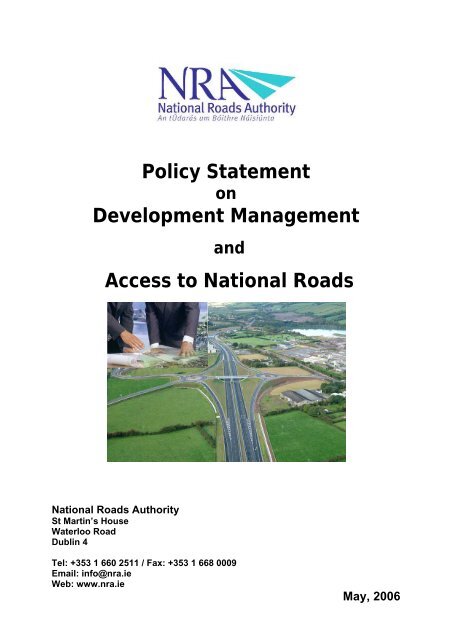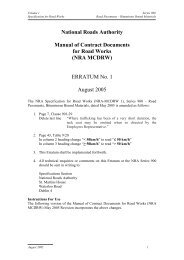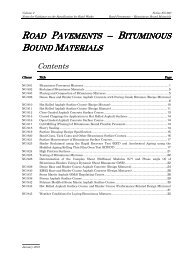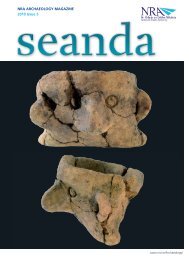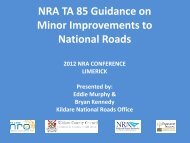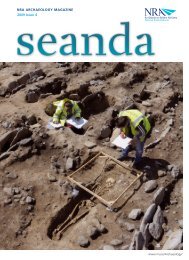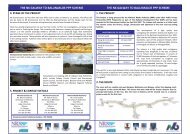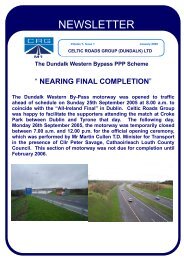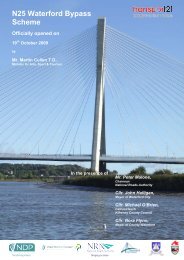Policy Statement on Development Management and Access to
Policy Statement on Development Management and Access to
Policy Statement on Development Management and Access to
You also want an ePaper? Increase the reach of your titles
YUMPU automatically turns print PDFs into web optimized ePapers that Google loves.
<str<strong>on</strong>g>Policy</str<strong>on</strong>g> <str<strong>on</strong>g>Statement</str<strong>on</strong>g><br />
<strong>on</strong><br />
<strong>Development</strong> <strong>Management</strong><br />
<strong>and</strong><br />
<strong>Access</strong> <strong>to</strong> Nati<strong>on</strong>al Roads<br />
Nati<strong>on</strong>al Roads Authority<br />
St Martin’s House<br />
Waterloo Road<br />
Dublin 4<br />
Tel: +353 1 660 2511 / Fax: +353 1 668 0009<br />
Email: info@nra.ie<br />
Web: www.nra.ie<br />
May, 2006
Nati<strong>on</strong>al Roads Authority <str<strong>on</strong>g>Policy</str<strong>on</strong>g> <str<strong>on</strong>g>Statement</str<strong>on</strong>g> <strong>on</strong> <strong>Development</strong> <strong>Management</strong> <strong>and</strong> <strong>Access</strong> <strong>to</strong> Nati<strong>on</strong>al Roads<br />
Foreword<br />
Part 1 – Introducti<strong>on</strong>.<br />
Index<br />
1.1 About this <str<strong>on</strong>g>Statement</str<strong>on</strong>g> 1<br />
1.2 Statu<strong>to</strong>ry Resp<strong>on</strong>sibility of the NRA 1<br />
1.3 Nati<strong>on</strong>al Road <strong>Development</strong> Strategy 1<br />
1.4 Protecting the Operati<strong>on</strong>al Efficiency <strong>and</strong> Capacity of Nati<strong>on</strong>al Roads 2<br />
1.5 Safety of Road Users 3<br />
1.6 Service <strong>and</strong> Rest Areas 3<br />
Part 2 – Nati<strong>on</strong>al Planning Policies <strong>and</strong> Guidelines.<br />
2.1 <strong>Development</strong> C<strong>on</strong>trol Advice <strong>and</strong> Guidelines <strong>and</strong> <str<strong>on</strong>g>Policy</str<strong>on</strong>g> <strong>and</strong> Planning<br />
Framework for Roads<br />
5<br />
2.2 Sustainable Rural Housing – Guidelines for Planning Authorities 5<br />
2.3 Retail Planning Guidelines 6<br />
2.4 Official <str<strong>on</strong>g>Policy</str<strong>on</strong>g> Objectives: Summary 7<br />
Part 3 – <strong>Development</strong> Plans <strong>and</strong> Planning Applicati<strong>on</strong>s.<br />
3.1 NRA Approach <strong>and</strong> Objectives 9<br />
3.2 <strong>Development</strong> Plans 10<br />
3.2.1 C<strong>on</strong>sultati<strong>on</strong> with Planning Authorities 10<br />
3.2.2 Preparati<strong>on</strong> <strong>and</strong> Review of <strong>Development</strong> Plans 10<br />
3.2.3 Impact of <strong>Development</strong> <strong>on</strong> Interchanges. 10<br />
3.2.4 Proposed <strong>Development</strong>s in Urban Areas <strong>and</strong> Designated <strong>Development</strong> 11<br />
Centres<br />
3.2.5 Protecting Route Opti<strong>on</strong>s for New or Improved Road Schemes 11<br />
3.2.6 Excepti<strong>on</strong>al Circumstances 12<br />
3.3 Planning Applicati<strong>on</strong>s 13<br />
3.3.1 Notificati<strong>on</strong> <strong>to</strong> NRA of Planning Applicati<strong>on</strong>s 13<br />
3.3.2 NRA Submissi<strong>on</strong>s <strong>and</strong> Observati<strong>on</strong>s 13<br />
3.3.3 <strong>Access</strong> <strong>to</strong> Nati<strong>on</strong>al Roads 14<br />
3.3.4 Road Safety Audits 14<br />
3.3.5 Traffic <strong>and</strong> Transport Assessments 15<br />
3.3.6 Financing of Road Upgrading Arising From Approved <strong>Development</strong> 15<br />
3.3.7 Notificati<strong>on</strong> <strong>to</strong> NRA of Decisi<strong>on</strong> <strong>to</strong> Approve C<strong>on</strong>trary <strong>to</strong> NRA<br />
Observati<strong>on</strong>s<br />
15<br />
3.3.8 Appeals by NRA <strong>to</strong> An Bord Pleanála 15<br />
i
Nati<strong>on</strong>al Roads Authority <str<strong>on</strong>g>Policy</str<strong>on</strong>g> <strong>on</strong> <strong>Development</strong> C<strong>on</strong>trol <strong>and</strong> <strong>Access</strong> <strong>to</strong> Nati<strong>on</strong>al Roads<br />
<str<strong>on</strong>g>Policy</str<strong>on</strong>g> <str<strong>on</strong>g>Statement</str<strong>on</strong>g> <strong>on</strong><br />
<strong>Development</strong><br />
<strong>Management</strong> <strong>and</strong><br />
<strong>Access</strong> <strong>to</strong> Nati<strong>on</strong>al<br />
Roads<br />
Foreword<br />
By<br />
Fred Barry, Chief Executive<br />
The unprecedented scale <strong>and</strong> pace of the nati<strong>on</strong>al road development programme that we<br />
have witnessed in recent years is set <strong>to</strong> c<strong>on</strong>tinue for the foreseeable future following the<br />
launch of Transport 21, the Government’s €34.4 billi<strong>on</strong> blueprint for the further development of<br />
Irel<strong>and</strong>’s l<strong>and</strong>, sea <strong>and</strong> air transport over the next decade. The Transport 21 strategy will see<br />
some €9.4 milli<strong>on</strong> invested every day for the next 10 years in Irish transport. Most importantly<br />
from the Authority’s perspective, the Government’s strategy provides financial assurances <strong>to</strong><br />
the Authority that will enable us <strong>to</strong> plan our development programme well in<strong>to</strong> the future as we<br />
c<strong>on</strong>tinue our task, in partnership with local authorities, of delivering a modern, safe <strong>and</strong><br />
efficient nati<strong>on</strong>al road network <strong>to</strong> serve the needs of our exp<strong>and</strong>ing ec<strong>on</strong>omy <strong>and</strong> improve our<br />
living st<strong>and</strong>ards.<br />
Clearly, there is an <strong>on</strong>us <strong>on</strong> all of us involved in the nati<strong>on</strong>al road development programme <strong>to</strong><br />
achieve maximum value for m<strong>on</strong>ey for the investment of the substantial funds being provided<br />
by Government. The new roads that are being c<strong>on</strong>structed throughout the country are being<br />
built <strong>to</strong> the highest internati<strong>on</strong>al st<strong>and</strong>ards <strong>and</strong> are typically designed <strong>to</strong> cater for road traffic<br />
needs over a twenty year horiz<strong>on</strong>, based primarily <strong>on</strong> anticipated traffic volumes related <strong>to</strong> the<br />
inter-urban <strong>and</strong> inter-regi<strong>on</strong>al transport functi<strong>on</strong> of nati<strong>on</strong>al roads. It is, therefore, incumbent<br />
up<strong>on</strong> us <strong>to</strong> ensure, in so far as is reas<strong>on</strong>ably practicable, that these roads will c<strong>on</strong>tinue <strong>to</strong><br />
serve their intended purpose of providing a safe <strong>and</strong> efficient nati<strong>on</strong>al transport network over<br />
the twenty-year design period, at a minimum.<br />
i
Nati<strong>on</strong>al Roads Authority <str<strong>on</strong>g>Policy</str<strong>on</strong>g> <strong>on</strong> <strong>Development</strong> C<strong>on</strong>trol <strong>and</strong> <strong>Access</strong> <strong>to</strong> Nati<strong>on</strong>al Roads<br />
Promoting good planning strategies <strong>and</strong> avoiding inappropriate development that negatively<br />
impacts <strong>on</strong> nati<strong>on</strong>al roads represent significant challenges <strong>to</strong> ensuring <strong>and</strong> maintaining the<br />
operati<strong>on</strong>al efficiency <strong>and</strong> safety of the upgraded nati<strong>on</strong>al road network. For this reas<strong>on</strong>, the<br />
Authority has published this <str<strong>on</strong>g>Policy</str<strong>on</strong>g> <str<strong>on</strong>g>Statement</str<strong>on</strong>g> with the primary aim of informing developers<br />
<strong>and</strong> decisi<strong>on</strong> makers of the principles guiding the Authority’s approach <strong>to</strong>wards proposed<br />
developments impacting up<strong>on</strong> nati<strong>on</strong>al roads.<br />
In publishing this <str<strong>on</strong>g>Statement</str<strong>on</strong>g> the Authority recognises, of course, that a wide range of issues<br />
must be c<strong>on</strong>sidered by planning authorities <strong>and</strong> An Bord Pleanála in dealing with each<br />
individual development proposal. Nati<strong>on</strong>al roads represent <strong>on</strong>ly <strong>on</strong>e, albeit an important, such<br />
issue. This <str<strong>on</strong>g>Statement</str<strong>on</strong>g> highlights the key policies <strong>and</strong> issues c<strong>on</strong>cerning nati<strong>on</strong>al roads such<br />
as the protecti<strong>on</strong> of the investment made in upgrading the network, maintaining<br />
efficiency/satisfac<strong>to</strong>ry level of service, preserving high st<strong>and</strong>ards of road safety <strong>and</strong> avoiding<br />
the premature erosi<strong>on</strong> of these benefits. It is the Authority’s hope that these matters will be<br />
properly taken in<strong>to</strong> account <strong>and</strong> given due c<strong>on</strong>siderati<strong>on</strong> <strong>and</strong> weighting in the decisi<strong>on</strong>-making<br />
process.<br />
Essentially, the primary aim of the <str<strong>on</strong>g>Statement</str<strong>on</strong>g> is <strong>to</strong>:<br />
• c<strong>on</strong>tribute <strong>to</strong> well informed planning decisi<strong>on</strong>s that represent the best opti<strong>on</strong> for<br />
sustainable development, taking account of all relevant c<strong>on</strong>siderati<strong>on</strong>s, <strong>and</strong><br />
• achieve c<strong>on</strong>sistency of approach nati<strong>on</strong>ally <strong>to</strong> planning <strong>and</strong> development issues<br />
affecting nati<strong>on</strong>al roads.<br />
A well-informed <strong>and</strong> c<strong>on</strong>sistent approach <strong>to</strong> planning <strong>and</strong> development issues, <strong>on</strong>e that<br />
affords maximum support for the goal of achieving <strong>and</strong> maintaining a safe <strong>and</strong> efficient<br />
network of nati<strong>on</strong>al roads in the broader c<strong>on</strong>text of sustainable development strategies, is in<br />
the interests of society generally by facilitating c<strong>on</strong>tinued ec<strong>on</strong>omic growth <strong>and</strong> development<br />
throughout the Regi<strong>on</strong>s. While the Authority recognises that decisi<strong>on</strong>s in relati<strong>on</strong> <strong>to</strong> planning<br />
issues are, of course, matters for the relevant planning authorities <strong>and</strong> An Bord Pleanála, it is<br />
hoped that the issues <strong>and</strong> policies which we have highlighted in this <str<strong>on</strong>g>Statement</str<strong>on</strong>g> will assist in<br />
the decisi<strong>on</strong> making process <strong>and</strong> ensure that Irel<strong>and</strong>’s nati<strong>on</strong>al road infrastructure provides<br />
the highest st<strong>and</strong>ards of efficiency <strong>and</strong> safety for all road users for many years <strong>to</strong> come.<br />
Fred Barry<br />
Chief Executive<br />
ii
Nati<strong>on</strong>al Roads Authority <str<strong>on</strong>g>Policy</str<strong>on</strong>g> <strong>on</strong> <strong>Development</strong> C<strong>on</strong>trol <strong>and</strong> <strong>Access</strong> <strong>to</strong> Nati<strong>on</strong>al Roads<br />
Part 1<br />
Introducti<strong>on</strong><br />
1.1. About this <str<strong>on</strong>g>Statement</str<strong>on</strong>g>.<br />
This <str<strong>on</strong>g>Statement</str<strong>on</strong>g> has been prepared <strong>to</strong> outline the Nati<strong>on</strong>al Roads Authority’s policy <strong>on</strong><br />
the management of developments impacting up<strong>on</strong> nati<strong>on</strong>al roads. The policy relates<br />
primarily <strong>to</strong> proposed developments located <strong>on</strong> nati<strong>on</strong>al roads outside the 50 kph<br />
speed limit z<strong>on</strong>es for cities, <strong>to</strong>wns <strong>and</strong> villages, but also addresses development<br />
proposals planned for other locati<strong>on</strong>s which, because of their potential <strong>to</strong> generate high<br />
volumes of traffic, could have significant implicati<strong>on</strong>s for nati<strong>on</strong>al roads in the area<br />
c<strong>on</strong>cerned.<br />
1.2. Statu<strong>to</strong>ry Resp<strong>on</strong>sibility of the NRA.<br />
The Nati<strong>on</strong>al Roads Authority is resp<strong>on</strong>sible for securing the provisi<strong>on</strong> of a safe <strong>and</strong><br />
efficient network of nati<strong>on</strong>al roads in accordance with secti<strong>on</strong> 17 of the Roads Act,<br />
1993.<br />
Nati<strong>on</strong>al roads play a key role in providing access <strong>to</strong> all regi<strong>on</strong>s of the country <strong>and</strong><br />
c<strong>on</strong>necti<strong>on</strong>s between the main centres of populati<strong>on</strong>. Although nati<strong>on</strong>al roads account<br />
for less than 6% of the <strong>to</strong>tal length of public roads throughout the country, i.e.<br />
approximately 5,400 km out of 94,600 km, their significance in serving our ec<strong>on</strong>omic<br />
<strong>and</strong> social transport needs is reflected in the fact that they carry over 40% of all road<br />
traffic in Irel<strong>and</strong>.<br />
1.3. Nati<strong>on</strong>al Road <strong>Development</strong> Strategy.<br />
This <str<strong>on</strong>g>Policy</str<strong>on</strong>g> <str<strong>on</strong>g>Statement</str<strong>on</strong>g> has been prepared having regard <strong>to</strong> the Government’s strategy<br />
for the development of the network of nati<strong>on</strong>al roads as set out in the Nati<strong>on</strong>al<br />
<strong>Development</strong> Plan <strong>and</strong> Transport 21. This development strategy provides for<br />
unprecedented levels of investment by Government in order <strong>to</strong> secure, in the shortest<br />
possible timeframe, a modern nati<strong>on</strong>al road network that will serve <strong>to</strong> underpin<br />
Irel<strong>and</strong>’s ec<strong>on</strong>omic success <strong>and</strong> competitiveness by providing faster, more efficient<br />
<strong>and</strong> safer access <strong>to</strong> <strong>and</strong> from our major ports, airports, cities <strong>and</strong> large <strong>to</strong>wns.<br />
A modern ec<strong>on</strong>omy requires a world-class road transport network that is sustainable<br />
from an ec<strong>on</strong>omic, social <strong>and</strong> envir<strong>on</strong>mental perspective. Better nati<strong>on</strong>al roads<br />
improve access <strong>to</strong> the Regi<strong>on</strong>s, enhancing their attractiveness for inward investment<br />
<strong>and</strong> new employment opportunities. In this way the nati<strong>on</strong>al road network c<strong>on</strong>tributes<br />
<strong>to</strong> the implementati<strong>on</strong> of the Government’s policy of promoting more balanced<br />
1
Nati<strong>on</strong>al Roads Authority <str<strong>on</strong>g>Policy</str<strong>on</strong>g> <strong>on</strong> <strong>Development</strong> C<strong>on</strong>trol <strong>and</strong> <strong>Access</strong> <strong>to</strong> Nati<strong>on</strong>al Roads<br />
development throughout the country <strong>and</strong> also facilitates implementati<strong>on</strong> of the Nati<strong>on</strong>al<br />
Spatial Strategy.<br />
1.4. Protecting the Operati<strong>on</strong>al Efficiency <strong>and</strong> Capacity of Nati<strong>on</strong>al Roads.<br />
The Nati<strong>on</strong>al Roads Authority, in partnership with local authorities, is working <strong>to</strong><br />
provide a high quality nati<strong>on</strong>al road network by removing inefficiencies such as<br />
bottlenecks <strong>and</strong> c<strong>on</strong>gesti<strong>on</strong>, thereby delivering positive benefits in terms of improved<br />
journey times, reduced envir<strong>on</strong>mental impacts <strong>and</strong> more efficient energy use.<br />
The strategy for the development of the network of nati<strong>on</strong>al roads is intended <strong>to</strong><br />
provide roads of a st<strong>and</strong>ard that will give a satisfac<strong>to</strong>ry level of service <strong>to</strong> road users<br />
(as manifested in the average speeds achieved), taking account of the growth in traffic<br />
over a design period of at least 20 years. The traffic carrying capacity of these roads,<br />
the level of service they deliver <strong>and</strong> the period over which they c<strong>on</strong>tinue <strong>to</strong> perform<br />
efficiently will be determined by a range of fac<strong>to</strong>rs in additi<strong>on</strong> <strong>to</strong> traffic growth, in<br />
particular:<br />
� the frequency of access points <strong>to</strong> the network;<br />
� the extent of development adjoining nati<strong>on</strong>al roads, including interchanges, <strong>and</strong><br />
in the envir<strong>on</strong>s of such roads, as well as<br />
� the traffic volumes generated by such development.<br />
Accordingly, appropriate development plan policies <strong>and</strong> development management<br />
approaches are required so as <strong>to</strong> maintain <strong>and</strong> protect the capacity <strong>and</strong> efficiency of<br />
nati<strong>on</strong>al roads, thereby extending their service life as dedicated transport corridors<br />
catering primarily for inter-urban <strong>and</strong> inter-regi<strong>on</strong>al traffic. Effective policies in this<br />
regard will help <strong>to</strong> achieve value for m<strong>on</strong>ey from the substantial investment being<br />
made in upgrading nati<strong>on</strong>al roads <strong>and</strong> in relati<strong>on</strong> <strong>to</strong> the protecti<strong>on</strong> of the infrastructure<br />
so created for the l<strong>on</strong>g term benefit of road users, communities generally <strong>and</strong> the<br />
ec<strong>on</strong>omy.<br />
On mo<strong>to</strong>rway <strong>and</strong> dual carriageway secti<strong>on</strong>s of the network, grade separated<br />
interchanges complying with the Authority’s Design Manual for Roads <strong>and</strong> Bridges<br />
provide a safe <strong>and</strong> efficient soluti<strong>on</strong> catering for traffic movements <strong>to</strong> <strong>and</strong> from<br />
mo<strong>to</strong>rways/dual carriageways <strong>and</strong> the adjoining local road network. The locati<strong>on</strong>,<br />
capacity <strong>and</strong> frequency of interchanges are determined as part of the road scheme<br />
planning process taking account, in particular, of populati<strong>on</strong> distributi<strong>on</strong> patterns, scale<br />
of urban areas <strong>and</strong> the origin <strong>and</strong> destinati<strong>on</strong> of traffic <strong>to</strong> be catered for al<strong>on</strong>g the<br />
proposed road. The Authority’s approach is <strong>to</strong> seek <strong>to</strong> match the interchange strategy<br />
<strong>to</strong> the road scheme design horiz<strong>on</strong> of at least 20 years based primarily <strong>on</strong> anticipated<br />
traffic volumes related <strong>to</strong> the inter-urban <strong>and</strong> inter-regi<strong>on</strong>al transport functi<strong>on</strong> of<br />
nati<strong>on</strong>al roads. In this way every effort is made <strong>to</strong> match the locati<strong>on</strong> <strong>and</strong> capacity of<br />
interchanges <strong>to</strong> traffic forecast requirements, thereby avoiding wastage of public<br />
2
Nati<strong>on</strong>al Roads Authority <str<strong>on</strong>g>Policy</str<strong>on</strong>g> <strong>on</strong> <strong>Development</strong> C<strong>on</strong>trol <strong>and</strong> <strong>Access</strong> <strong>to</strong> Nati<strong>on</strong>al Roads<br />
expenditure that would occur through either over-design or under-design of<br />
interchanges.<br />
<strong>Development</strong> plan policies should reflect <strong>and</strong> safeguard the strategic role of<br />
interchanges in catering for the safe <strong>and</strong> efficient movement of inter-urban <strong>and</strong> interregi<strong>on</strong>al<br />
traffic. In particular, policies should be adopted so as <strong>to</strong> avoid the undermining<br />
of the strategic transport functi<strong>on</strong> of nati<strong>on</strong>al roads, including interchanges, by<br />
measures intended <strong>to</strong> cater for the needs of local traffic which should more<br />
appropriately be addressed within the framework of providing an adequate local road<br />
infrastructure.<br />
1.5. Safety of Road Users.<br />
The Nati<strong>on</strong>al Roads Authority, as already indicated, is resp<strong>on</strong>sible for securing a safe<br />
<strong>and</strong> efficient network of nati<strong>on</strong>al roads. Newly c<strong>on</strong>structed nati<strong>on</strong>al roads, designed<br />
<strong>and</strong> built <strong>to</strong> best internati<strong>on</strong>al st<strong>and</strong>ards, have significantly lower accident rates <strong>and</strong><br />
fewer fatalities than the older, unimproved secti<strong>on</strong>s of the network. Mo<strong>to</strong>rways perform<br />
best in this regard, followed by dual carriageway st<strong>and</strong>ard roads. The situati<strong>on</strong> reflects<br />
the separati<strong>on</strong> of traffic flows <strong>and</strong> the use of purpose designed slip roads <strong>and</strong><br />
interchanges that cater for traffic movements <strong>on</strong><strong>to</strong> <strong>and</strong> off mo<strong>to</strong>rways <strong>and</strong> dual<br />
carriageways. However, roads of this st<strong>and</strong>ard cannot be justified <strong>on</strong> all secti<strong>on</strong>s of<br />
the network having regard <strong>to</strong> the anticipated traffic volumes in<strong>to</strong> the future <strong>and</strong> the cost<br />
of such roads.<br />
The performance <strong>and</strong> safety record of two-lane roads <strong>and</strong> the 2-plus-1 road type being<br />
piloted by the Authority are str<strong>on</strong>gly influenced by the frequency of juncti<strong>on</strong>s with side<br />
roads <strong>and</strong> the occurrence of entrances <strong>to</strong> roadside development, including industrial<br />
<strong>and</strong> commercial enterprises, farms <strong>and</strong> residential development, as well as <strong>on</strong>ce-off<br />
housing. These features <strong>and</strong> developments give rise <strong>to</strong> turning movements that entail<br />
significant safety risks <strong>to</strong> road users joining or leaving the main road <strong>and</strong> for other<br />
traffic already <strong>on</strong> the road. An analysis of road accident data indicates that more than<br />
50% (33,665) of all injury accidents reported <strong>on</strong> Irish roads over the period 1996-2004<br />
occurred at juncti<strong>on</strong>s or involved turning movements <strong>on</strong><strong>to</strong>/off roads. The fatalities in<br />
these accidents <strong>to</strong>talled 964, or 26% of overall road accident fatalities (3,707) recorded<br />
during the period.<br />
The Authority, therefore, supports a strategy that seeks <strong>to</strong> prevent a proliferati<strong>on</strong> of<br />
roadside developments al<strong>on</strong>g nati<strong>on</strong>al roads <strong>to</strong> which high speed limits apply, i.e.<br />
greater than 50 kph, as part of a broad based strategy aimed at reducing fatalities <strong>on</strong><br />
such roads.<br />
1.6. Service <strong>and</strong> Rest Areas.<br />
The Authority’s <str<strong>on</strong>g>Policy</str<strong>on</strong>g> <str<strong>on</strong>g>Statement</str<strong>on</strong>g> <strong>on</strong> the Provisi<strong>on</strong> of Service Areas <strong>and</strong> Rest Areas <strong>on</strong><br />
Mo<strong>to</strong>rways <strong>and</strong> High Quality Dual Carriageways recommends the provisi<strong>on</strong> of such<br />
facilities at intervals of approximately 50-60 km <strong>and</strong> 25-30 km respectively. The<br />
strategy for the provisi<strong>on</strong> of service areas will entail a combinati<strong>on</strong> of facilities located<br />
3
Nati<strong>on</strong>al Roads Authority <str<strong>on</strong>g>Policy</str<strong>on</strong>g> <strong>on</strong> <strong>Development</strong> C<strong>on</strong>trol <strong>and</strong> <strong>Access</strong> <strong>to</strong> Nati<strong>on</strong>al Roads<br />
<strong>on</strong>-line (where proposals are brought forward by local authorities in c<strong>on</strong>juncti<strong>on</strong> with<br />
the Authority) <strong>and</strong> at or close <strong>to</strong> interchanges (in the case of proposals promoted by<br />
commercial interests).<br />
Local authorities, acting in c<strong>on</strong>juncti<strong>on</strong> with the Authority, will arrange for a limited<br />
number of <strong>on</strong>-line mo<strong>to</strong>rway <strong>and</strong> dual carriageway service areas. These service areas<br />
will be provided in accordance with a c<strong>on</strong>ceptual design prepared by the Authority so<br />
as <strong>to</strong> achieve best practice in catering safely for traffic movements <strong>to</strong> <strong>and</strong> from such<br />
areas.<br />
4
Nati<strong>on</strong>al Roads Authority <str<strong>on</strong>g>Policy</str<strong>on</strong>g> <strong>on</strong> <strong>Development</strong> C<strong>on</strong>trol <strong>and</strong> <strong>Access</strong> <strong>to</strong> Nati<strong>on</strong>al Roads<br />
Part 2<br />
Nati<strong>on</strong>al Planning Policies <strong>and</strong> Guidelines<br />
2.1 “<strong>Development</strong> C<strong>on</strong>trol Advice <strong>and</strong> Guidelines” (1982) <strong>and</strong> “<str<strong>on</strong>g>Policy</str<strong>on</strong>g> <strong>and</strong><br />
Planning Framework for Roads” (1985).<br />
Official policy c<strong>on</strong>cerning developments involving access <strong>to</strong> nati<strong>on</strong>al roads <strong>and</strong><br />
developments al<strong>on</strong>g such roads, including ribb<strong>on</strong> development, is set out in the<br />
publicati<strong>on</strong>s “<strong>Development</strong> C<strong>on</strong>trol Advice <strong>and</strong> Guidelines” <strong>and</strong> “<str<strong>on</strong>g>Policy</str<strong>on</strong>g> <strong>and</strong> Planning<br />
Framework for Roads” which were issued respectively in 1982 <strong>and</strong> 1985 by the<br />
Department of the Envir<strong>on</strong>ment. The policy is given practical expressi<strong>on</strong> in the<br />
Department’s 1982 document which stipulates that “As a general policy, the locati<strong>on</strong><br />
of new means of access <strong>to</strong> the Nati<strong>on</strong>al Primary Roads, or residential,<br />
commercial, industrial or other development dependent <strong>on</strong> such means of access,<br />
should not be permitted except in areas where a speed limit of 30-40 mph<br />
[equivalent <strong>to</strong> 50-60 kph] applies, or in the case of infilling, in the existing built-up<br />
areas”. The document points out that the same c<strong>on</strong>siderati<strong>on</strong>s also apply <strong>to</strong> Nati<strong>on</strong>al<br />
Sec<strong>on</strong>dary Roads.<br />
The 1985 <str<strong>on</strong>g>Policy</str<strong>on</strong>g> <strong>and</strong> Framework document states that it is “Government policy that<br />
this investment (in nati<strong>on</strong>al roads) should be safeguarded by preventing the<br />
premature obsolescence of those roads as a result of inadequate c<strong>on</strong>trol <strong>on</strong><br />
fr<strong>on</strong>tage development. Experience <strong>and</strong> research has shown that failure <strong>to</strong><br />
effectively c<strong>on</strong>trol fr<strong>on</strong>tage development reduces traffic capacity of a particular<br />
road, shortens its useful life <strong>and</strong> requires its earlier than necessary replacement.<br />
This reduces the benefits <strong>to</strong> be derived from road investment, places an increased<br />
burden <strong>on</strong> taxpayers <strong>and</strong> diverts resources from other essential road works.<br />
Inadequate c<strong>on</strong>trol of fr<strong>on</strong>tage development also adversely affects road safety.<br />
This leads <strong>to</strong> an increased road accident <strong>and</strong> casualty rate, which has a direct<br />
impact both in terms of the pers<strong>on</strong>al loss <strong>to</strong> families <strong>and</strong> the ec<strong>on</strong>omic loss <strong>to</strong> the<br />
country”.<br />
2.2 “Sustainable Rural Housing – Guidelines for Planning Authorities”.<br />
The nati<strong>on</strong>al policies set out in “<strong>Development</strong> C<strong>on</strong>trol Advice <strong>and</strong> Guidelines” <strong>and</strong><br />
“<str<strong>on</strong>g>Policy</str<strong>on</strong>g> <strong>and</strong> Planning Framework for Roads” were reiterated in the document<br />
“Sustainable Rural Housing – Guidelines for Planning Authorities” which was published<br />
by the Department of the Envir<strong>on</strong>ment, Heritage <strong>and</strong> Local Government in April, 2005.<br />
5
Nati<strong>on</strong>al Roads Authority <str<strong>on</strong>g>Policy</str<strong>on</strong>g> <strong>on</strong> <strong>Development</strong> C<strong>on</strong>trol <strong>and</strong> <strong>Access</strong> <strong>to</strong> Nati<strong>on</strong>al Roads<br />
Included in these Guidelines is a requirement that “the objectives <strong>and</strong> policies of<br />
development plans should make it clear that direct access from future<br />
development should not be permitted <strong>to</strong> nati<strong>on</strong>al roads outside the speed limit<br />
z<strong>on</strong>es for <strong>to</strong>wns <strong>and</strong> villages”. The Guidelines also state that, “Key objectives <strong>and</strong><br />
policies <strong>to</strong> be included in the development plan should focus <strong>on</strong> the efficient<br />
<strong>on</strong>going development <strong>and</strong> safe operati<strong>on</strong> of roads, with particular emphasis <strong>on</strong><br />
the nati<strong>on</strong>al primary, nati<strong>on</strong>al sec<strong>on</strong>dary (<strong>and</strong> regi<strong>on</strong>al) road network.” To this end,<br />
the Guidelines recommend that “<strong>Development</strong> c<strong>on</strong>trol policy should, in the first<br />
instance, seek <strong>to</strong> channel traffic from new development <strong>on</strong><strong>to</strong> existing local roads<br />
<strong>and</strong> in this way use established access points <strong>to</strong> gain entry <strong>on</strong><strong>to</strong> nati<strong>on</strong>al roads”.<br />
The 2005 Guidelines indicate that, in dealing with the issue of housing in rural areas,<br />
local authority development plans need <strong>to</strong> include objectives in relati<strong>on</strong> <strong>to</strong> the future<br />
development <strong>and</strong> safe operati<strong>on</strong> of transport infrastructure. It is noted that many<br />
development plans already c<strong>on</strong>tain objectives regarding the need <strong>to</strong> protect the routes<br />
of future roads from development <strong>and</strong> the Guidelines recommend that this practice<br />
should c<strong>on</strong>tinue.<br />
Planning authorities <strong>and</strong> An Bord Pleanála must have regard <strong>to</strong> the Ministerial<br />
Guidelines <strong>on</strong> Sustainable Rural Housing in the performance of their functi<strong>on</strong>s in<br />
accordance with the provisi<strong>on</strong>s of secti<strong>on</strong> 28 of the Planning <strong>and</strong> <strong>Development</strong> Act,<br />
2000.<br />
2.3 Retail Planning Guidelines.<br />
Secti<strong>on</strong> 28 of the 2000 Act has also been used by the Minister for the Envir<strong>on</strong>ment,<br />
Heritage <strong>and</strong> Local Government when issuing Retail Planning Guidelines (January,<br />
2005) <strong>to</strong> planning authorities. Those Guidelines noted (paragraph 21) that “The<br />
challenge <strong>to</strong> be faced is how <strong>to</strong> accommodate the additi<strong>on</strong>al [retail] development<br />
that is projected <strong>to</strong> be required in a way which is efficient, equitable <strong>and</strong><br />
sustainable. It is important <strong>to</strong> establish the optimum locati<strong>on</strong> for new retail<br />
development which is accessible <strong>to</strong> all secti<strong>on</strong>s of society <strong>and</strong> is of a scale which<br />
allows the c<strong>on</strong>tinued prosperity of traditi<strong>on</strong>al <strong>to</strong>wn centres <strong>and</strong> existing retail<br />
centres. This can <strong>on</strong>ly be achieved if strategic retail policies <strong>and</strong> proposals are<br />
incorporated in the development plan system.”<br />
Three of five key objectives identified in the Retail Planning Guidelines c<strong>on</strong>cern issues<br />
of accessibility <strong>and</strong> locati<strong>on</strong> in the c<strong>on</strong>text of the c<strong>on</strong>tinuing role of <strong>to</strong>wn <strong>and</strong> district<br />
centres <strong>and</strong> proximity <strong>to</strong> existing, new or planned nati<strong>on</strong>al roads/mo<strong>to</strong>rways. In dealing<br />
with these matters the Guidelines stated:<br />
“24. Retail development is most accessible <strong>to</strong> cus<strong>to</strong>mers where it is well located<br />
within its catchment area <strong>and</strong> is accessed both by public transport <strong>and</strong> the<br />
private car. The third objective of policy, therefore, is <strong>to</strong> promote forms of<br />
development which are easily accessible – particularly by public transport<br />
– in a locati<strong>on</strong> which encourages multi-purpose shopping, business <strong>and</strong><br />
leisure trips <strong>on</strong> the same journey.<br />
6
Nati<strong>on</strong>al Roads Authority <str<strong>on</strong>g>Policy</str<strong>on</strong>g> <strong>on</strong> <strong>Development</strong> C<strong>on</strong>trol <strong>and</strong> <strong>Access</strong> <strong>to</strong> Nati<strong>on</strong>al Roads<br />
25. C<strong>on</strong>sequently, the fourth objective is <strong>to</strong> support the c<strong>on</strong>tinuing role of<br />
<strong>to</strong>wn <strong>and</strong> district centres. This will assist in reinforcing the investment in<br />
urban renewal which has been made already. These established centres<br />
should be the preferred locati<strong>on</strong>s for developments that attract many trips.<br />
This policy will also support their role as centres of social <strong>and</strong> business<br />
interacti<strong>on</strong> in the community. In order <strong>to</strong> achieve this objective the<br />
preferred locati<strong>on</strong> for retain development should be within <strong>to</strong>wn centres,<br />
c<strong>on</strong>sistent with the requirement <strong>to</strong> achieve good access especially by<br />
public transport. If there are no development sites available within a <strong>to</strong>wn<br />
centre then the next preference should be a locati<strong>on</strong> <strong>on</strong> the edge of the<br />
<strong>to</strong>wn centre. Only where there are no sites, or potential sites, within a <strong>to</strong>wn<br />
centre or <strong>on</strong> its edge, or satisfac<strong>to</strong>ry transport accessibility (including park<br />
<strong>and</strong> ride) realistically cannot be ensured within a reas<strong>on</strong>able period of time,<br />
should out of centre development be c<strong>on</strong>templated.<br />
26. The fifth, <strong>and</strong> final objective is a presumpti<strong>on</strong> against large retail centres<br />
located adjacent or close <strong>to</strong> existing, new or planned nati<strong>on</strong>al<br />
roads/mo<strong>to</strong>rways. Such centres can lead <strong>to</strong> an inefficient use of costly <strong>and</strong><br />
valuable infrastructure <strong>and</strong> may have the potential <strong>to</strong> undermine the<br />
regi<strong>on</strong>al/nati<strong>on</strong>al transport role of the roads c<strong>on</strong>cerned. However, as a<br />
limited excepti<strong>on</strong>, large retail warehouses may be c<strong>on</strong>sidered for locati<strong>on</strong>s<br />
close <strong>to</strong> such road networks where the proposed development would be<br />
situated in an Integrated Area Plan area in a Gateway (designated by the<br />
Nati<strong>on</strong>al Spatial Strategy) <strong>and</strong> where the road network has sufficient<br />
capacity <strong>to</strong> cater for the scale of development proposed.”<br />
According <strong>to</strong> the Guidelines, the stipulati<strong>on</strong> c<strong>on</strong>cerning road network capacity<br />
requirements for large retail warehouse developments, i.e. individual developments with a<br />
floorspace in excess of 6,000 square metres gross, in an Integrated Area Plan Gateway<br />
area would, in practice, necessitate the locati<strong>on</strong> of such developments close <strong>to</strong> a high<br />
capacity mo<strong>to</strong>rway or dual carriageway network <strong>and</strong> associated interchange. The<br />
planning process applying <strong>to</strong> such retail warehouses requires that proposals are<br />
accompanied by traffic impact assessments dem<strong>on</strong>strating compliance, inter alia, with the<br />
criteri<strong>on</strong> <strong>on</strong> road network capacity <strong>and</strong> as regards access by existing or planned public<br />
transport services in order <strong>to</strong> be acceptable from a planning viewpoint (paragraph 84d).<br />
2.4 Official <str<strong>on</strong>g>Policy</str<strong>on</strong>g> Objectives: Summary.<br />
In summary, the objectives of the various official policies <strong>and</strong> guidelines already outlined<br />
are <strong>to</strong>:<br />
� protect the substantial investment being made by Government in upgrading<br />
nati<strong>on</strong>al roads;<br />
� maintain the intended transport functi<strong>on</strong>, traffic carrying capacity <strong>and</strong> efficiency of<br />
the network of nati<strong>on</strong>al roads;<br />
7
Nati<strong>on</strong>al Roads Authority <str<strong>on</strong>g>Policy</str<strong>on</strong>g> <strong>on</strong> <strong>Development</strong> C<strong>on</strong>trol <strong>and</strong> <strong>Access</strong> <strong>to</strong> Nati<strong>on</strong>al Roads<br />
� ensure high st<strong>and</strong>ards of safety for road users <strong>and</strong> that these st<strong>and</strong>ards are not<br />
compromised by risks arising from traffic movements associated with multiple<br />
access points <strong>to</strong> the network;<br />
� extend the service life of the nati<strong>on</strong>al road network, thereby deferring <strong>to</strong> the l<strong>on</strong>ger<br />
term the need <strong>to</strong> reinvest in further road improvements <strong>and</strong> the c<strong>on</strong>structi<strong>on</strong> of new<br />
roads which would have implicati<strong>on</strong>s for l<strong>and</strong>owners, local communities, the<br />
envir<strong>on</strong>ment <strong>and</strong> public expenditure;<br />
� protect the routes of future roads, including road upgrades, from development;<br />
� str<strong>on</strong>gly advocate the use of established <strong>to</strong>wn <strong>and</strong> district centres as the preferred<br />
locati<strong>on</strong>s for new retail developments that attract many trips, <strong>and</strong><br />
� establish a presumpti<strong>on</strong> against large retail centres being located adjacent or close<br />
<strong>to</strong> existing, new or planned nati<strong>on</strong>al roads/mo<strong>to</strong>rways as such centres can lead <strong>to</strong><br />
an inefficient use of costly infrastructure, may undermine the regi<strong>on</strong>al/nati<strong>on</strong>al<br />
transport role of the roads c<strong>on</strong>cerned <strong>and</strong> could c<strong>on</strong>flict with the official policy<br />
preference for locati<strong>on</strong>s in established <strong>to</strong>wn <strong>and</strong> district centres.<br />
(However, as a limited excepti<strong>on</strong>, large retail warehouses may be c<strong>on</strong>sidered for<br />
locati<strong>on</strong>s close <strong>to</strong> such road networks if situated in an Integrated Area Plan area in<br />
a Gateway designated by the Nati<strong>on</strong>al Spatial Strategy, provided the road network<br />
has sufficient capacity <strong>to</strong> cater for the development proposed).<br />
8
Nati<strong>on</strong>al Roads Authority <str<strong>on</strong>g>Policy</str<strong>on</strong>g> <strong>on</strong> <strong>Development</strong> C<strong>on</strong>trol <strong>and</strong> <strong>Access</strong> <strong>to</strong> Nati<strong>on</strong>al Roads<br />
Part 3<br />
<strong>Development</strong> Plans <strong>and</strong><br />
Planning Applicati<strong>on</strong>s<br />
3.1. NRA Approach <strong>and</strong> Objectives.<br />
The approach <strong>to</strong> be adopted by the Authority in relati<strong>on</strong> <strong>to</strong>, (i) proposals by planning<br />
authorities <strong>to</strong> amend their development plans <strong>and</strong> (ii) planning applicati<strong>on</strong>s for<br />
development that could affect the safety <strong>and</strong> efficiency of nati<strong>on</strong>al roads, will seek <strong>to</strong><br />
uphold official policy <strong>and</strong> guidelines, as outlined in Part 2, for the management of<br />
development <strong>and</strong> access <strong>to</strong> nati<strong>on</strong>al roads.<br />
In line with that policy, the Authority will seek <strong>to</strong> limit accesses <strong>to</strong>/from mo<strong>to</strong>rways<br />
<strong>and</strong> dual carriageways <strong>to</strong>:<br />
� approved interchanges,<br />
� <strong>on</strong>-line service areas <strong>and</strong> rest areas provided at the instigati<strong>on</strong> of local<br />
authorities in c<strong>on</strong>juncti<strong>on</strong> with the Authority, <strong>and</strong><br />
� Garda enforcement platforms.<br />
Save in excepti<strong>on</strong>al circumstances, the Authority will generally adopt a restrictive<br />
approach in the case of other nati<strong>on</strong>al roads <strong>to</strong> which speed limits greater than<br />
50 kph apply as regards development proposals involving new accesses or the<br />
generati<strong>on</strong> of increased traffic from existing operati<strong>on</strong>s <strong>and</strong> activities <strong>on</strong> such roads.<br />
Secti<strong>on</strong>s of nati<strong>on</strong>al roads <strong>on</strong> the approaches <strong>to</strong> or exits from urban centres may be<br />
subject <strong>to</strong> a speed limit of 60 kph. These secti<strong>on</strong>s are intended <strong>to</strong> act as z<strong>on</strong>es of<br />
transiti<strong>on</strong> between areas <strong>to</strong> which higher (in the outward directi<strong>on</strong>) <strong>and</strong> lower (in the<br />
inward directi<strong>on</strong>) speed limits apply. Z<strong>on</strong>es of transiti<strong>on</strong> should be preserved free<br />
from development entailing direct access <strong>to</strong> the secti<strong>on</strong>s of nati<strong>on</strong>al road c<strong>on</strong>cerned<br />
in the interests of safety.<br />
9
Nati<strong>on</strong>al Roads Authority <str<strong>on</strong>g>Policy</str<strong>on</strong>g> <strong>on</strong> <strong>Development</strong> C<strong>on</strong>trol <strong>and</strong> <strong>Access</strong> <strong>to</strong> Nati<strong>on</strong>al Roads<br />
3.2. <strong>Development</strong> Plans.<br />
3.2.1. C<strong>on</strong>sultati<strong>on</strong> with Planning Authorities.<br />
The Authority will seek <strong>to</strong> engage proactively with planning authorities <strong>on</strong> those<br />
aspects of development plans that c<strong>on</strong>cern or could impact <strong>on</strong> nati<strong>on</strong>al roads<br />
with a view <strong>to</strong> establishing appropriate strategies <strong>and</strong> provisi<strong>on</strong>s that can cater<br />
for future sustainable development while simultaneously respecting <strong>to</strong> the<br />
extent possible the official policy objectives set out in Part 2.<br />
3.2.2. Preparati<strong>on</strong> <strong>and</strong> Review of <strong>Development</strong> Plans.<br />
Secti<strong>on</strong> 22 of the Roads Act, 1993, enables the Authority <strong>to</strong> make<br />
recommendati<strong>on</strong>s <strong>to</strong> a planning authority regarding the c<strong>on</strong>tent of that<br />
authority’s development plan. The planning authority is obliged <strong>to</strong> c<strong>on</strong>sider any<br />
recommendati<strong>on</strong> made. In additi<strong>on</strong>, the Authority is c<strong>on</strong>sulted by planning<br />
authorities <strong>on</strong> their proposals <strong>to</strong> amend their development plans. Aspects of<br />
particular interest from the nati<strong>on</strong>al roads perspective would include proposed<br />
changes, including rez<strong>on</strong>ing, with implicati<strong>on</strong>s for access <strong>to</strong> nati<strong>on</strong>al roads <strong>and</strong><br />
for the traffic carrying capacity <strong>and</strong> operati<strong>on</strong>al efficiency of such roads,<br />
including interchanges, as well as effects <strong>on</strong> road scheme costs as a<br />
c<strong>on</strong>sequence of increased l<strong>and</strong> values linked <strong>to</strong> rez<strong>on</strong>ing. In the event of the<br />
Authority deciding <strong>to</strong> make recommendati<strong>on</strong>s <strong>on</strong> proposed amendments <strong>to</strong> a<br />
development plan it would be guided by the policies <strong>and</strong> objectives set out in<br />
Part 2.<br />
As part of the process for the review of development plans, planning authorities<br />
are required under secti<strong>on</strong> 11(3)(c) of the Planning <strong>and</strong> <strong>Development</strong> Act,<br />
2000, <strong>to</strong> c<strong>on</strong>sult with the Authority so as <strong>to</strong> ascertain any l<strong>on</strong>g-term plans in<br />
respect of the provisi<strong>on</strong> <strong>and</strong> upgrading of nati<strong>on</strong>al roads in their areas. This<br />
provides a valuable mechanism whereby potential routes for new roads or<br />
planned significant improvements <strong>to</strong> existing roads can be notified <strong>to</strong> planning<br />
authorities <strong>and</strong> appropriate provisi<strong>on</strong> made in development plans so as <strong>to</strong><br />
facilitate the future delivery of the road schemes c<strong>on</strong>cerned.<br />
3.2.3. Impact of <strong>Development</strong> <strong>on</strong> Interchanges.<br />
As indicated in secti<strong>on</strong> 1.4, the locati<strong>on</strong> <strong>and</strong> capacity of interchanges <strong>on</strong><br />
nati<strong>on</strong>al roads are determined during the road planning process having regard<br />
<strong>to</strong> a range of fac<strong>to</strong>rs <strong>and</strong> taking account, in particular, of anticipated inter-urban<br />
<strong>and</strong> inter-regi<strong>on</strong>al traffic volumes over a design horiz<strong>on</strong> of at least 20 years. A<br />
key objective of the approach <strong>to</strong> road planning is <strong>to</strong> achieve a satisfac<strong>to</strong>ry level<br />
10
Nati<strong>on</strong>al Roads Authority <str<strong>on</strong>g>Policy</str<strong>on</strong>g> <strong>on</strong> <strong>Development</strong> C<strong>on</strong>trol <strong>and</strong> <strong>Access</strong> <strong>to</strong> Nati<strong>on</strong>al Roads<br />
of service for road users <strong>and</strong> <strong>to</strong> protect <strong>and</strong> maintain that service over the<br />
design period applying <strong>to</strong> the mainline road <strong>and</strong> associated interchanges. In<br />
the circumstances, it will be necessary for planning authorities <strong>to</strong> exercise<br />
particular care in their assessment <strong>and</strong> management of development proposals<br />
relating <strong>to</strong> the rez<strong>on</strong>ing of locati<strong>on</strong>s at or close <strong>to</strong> interchanges where such<br />
development could generate significant additi<strong>on</strong>al traffic, thereby potentially<br />
compromising the capacity <strong>and</strong> efficiency of the nati<strong>on</strong>al road/associated<br />
interchanges <strong>and</strong> possibly leading <strong>to</strong> the premature <strong>and</strong> unacceptable<br />
reducti<strong>on</strong> in the level of service available <strong>to</strong> road users. Planning authorities, in<br />
c<strong>on</strong>sidering proposals for rez<strong>on</strong>ings adjacent or close <strong>to</strong> existing or planned<br />
nati<strong>on</strong>al roads/mo<strong>to</strong>rways <strong>and</strong> interchanges, should give special attenti<strong>on</strong> <strong>to</strong><br />
the preference expressed in the Retail Planning Guidelines for locating<br />
developments that attract many trips within established <strong>to</strong>wns <strong>and</strong> district<br />
centres. The Authority would welcome dialogue with planning authorities <strong>on</strong> all<br />
rez<strong>on</strong>ing proposals of this nature with a view <strong>to</strong> adopting an agreed<br />
methodology <strong>to</strong> assess traffic <strong>and</strong> transport implicati<strong>on</strong>s <strong>and</strong> impacts <strong>on</strong> the<br />
operati<strong>on</strong> <strong>and</strong> performance of relevant interchanges <strong>and</strong> nati<strong>on</strong>al roads as an<br />
aid <strong>to</strong> devising appropriate <strong>and</strong> sustainable development strategies.<br />
3.2.4. Proposed <strong>Development</strong>s in Urban Areas <strong>and</strong> Designated<br />
<strong>Development</strong> Centres.<br />
The Authority can support practices aimed at c<strong>on</strong>centrating development in<br />
established urban areas <strong>and</strong> designated development centres. C<strong>on</strong>solidati<strong>on</strong><br />
<strong>and</strong>, as appropriate, expansi<strong>on</strong> of such locati<strong>on</strong>s might ideally be pursued<br />
within an integrated l<strong>and</strong> use <strong>and</strong> transportati<strong>on</strong> strategy informed by<br />
sustainable development c<strong>on</strong>siderati<strong>on</strong>s.<br />
3.2.5. Protecting Route Opti<strong>on</strong>s for New or Improved Road Schemes.<br />
Planning for new roads typically involves the identificati<strong>on</strong> <strong>and</strong> evaluati<strong>on</strong> of a<br />
number of route opti<strong>on</strong>s taking account of envir<strong>on</strong>mental, engineering, traffic<br />
<strong>and</strong> cost fac<strong>to</strong>rs. Some time is required <strong>to</strong> complete this process <strong>and</strong> <strong>to</strong> identify<br />
the preferred route opti<strong>on</strong>, which, <strong>on</strong> balance, is assessed as representing the<br />
optimum soluti<strong>on</strong>. The selected route is subsequently subjected <strong>to</strong> more<br />
detailed evaluati<strong>on</strong>, including, where appropriate, the preparati<strong>on</strong> of an<br />
Envir<strong>on</strong>mental Impact Assessment <strong>and</strong> a Mo<strong>to</strong>rway Scheme/Compulsory<br />
Purchase Order which provide the basis for seeking the approval of An Bord<br />
Pleanála <strong>to</strong> the proposed road as well as the acquisiti<strong>on</strong> of the necessary l<strong>and</strong>s<br />
up<strong>on</strong> which <strong>to</strong> c<strong>on</strong>struct the road. Ideally, planning authority proposals <strong>to</strong><br />
rez<strong>on</strong>e l<strong>and</strong> should not compromise the road planning <strong>and</strong> route opti<strong>on</strong><br />
evaluati<strong>on</strong> process in circumstances where road scheme planning is underway<br />
<strong>and</strong> potential routes have been identified <strong>and</strong> brought <strong>to</strong> the attenti<strong>on</strong> of the<br />
planning authority. Similarly, rez<strong>on</strong>ing proposals should not have the effect of<br />
increasing the cost of l<strong>and</strong> <strong>to</strong> be acquired or under active c<strong>on</strong>siderati<strong>on</strong> as a<br />
route opti<strong>on</strong> for a nati<strong>on</strong>al road scheme. Such proposals, while potentially<br />
bringing major financial gains <strong>to</strong> the property owners involved, would be at<br />
11
Nati<strong>on</strong>al Roads Authority <str<strong>on</strong>g>Policy</str<strong>on</strong>g> <strong>on</strong> <strong>Development</strong> C<strong>on</strong>trol <strong>and</strong> <strong>Access</strong> <strong>to</strong> Nati<strong>on</strong>al Roads<br />
variance with the broader public interest <strong>and</strong> would, by significantly increasing<br />
the cost of the l<strong>and</strong> <strong>to</strong> be acquired for road schemes, reduce the funding<br />
available <strong>to</strong> the Authority for road c<strong>on</strong>structi<strong>on</strong> <strong>and</strong> improvement work<br />
generally. Accordingly, where circumstances warrant, the Authority will make<br />
recommendati<strong>on</strong>s <strong>to</strong> planning authorities c<strong>on</strong>cerning amendments <strong>to</strong><br />
development plans with a view <strong>to</strong> maintaining road scheme route opti<strong>on</strong>s while<br />
planning proceeds <strong>and</strong> avoiding unnecessary increases in the cost of l<strong>and</strong><br />
required for road related purposes.<br />
The Authority is c<strong>on</strong>scious of the uncertainty created as a c<strong>on</strong>sequence of the<br />
time taken <strong>to</strong> progress the road scheme route selecti<strong>on</strong> process <strong>and</strong> the<br />
implicati<strong>on</strong>s this has for potential development <strong>and</strong> related planning<br />
applicati<strong>on</strong>s <strong>on</strong> the various route opti<strong>on</strong>s under investigati<strong>on</strong>. The Authority is,<br />
however, committed <strong>to</strong> completing the route selecti<strong>on</strong> process within the<br />
shortest feasible timeframe, thereby bringing certainty <strong>to</strong> the situati<strong>on</strong> <strong>and</strong><br />
allowing interested parties <strong>and</strong> individuals <strong>to</strong> make planning applicati<strong>on</strong>s in<br />
respect of route opti<strong>on</strong>s other than the selected route.<br />
3.2.6. Excepti<strong>on</strong>al Circumstances.<br />
The restrictive approach <strong>to</strong> development <strong>on</strong> nati<strong>on</strong>al roads <strong>to</strong> which speed<br />
limits greater than 50 kph apply (paragraph 3.1) may be reviewed as part of the<br />
interface between the Authority <strong>and</strong> planning authorities so as <strong>to</strong> take account<br />
of any relevant excepti<strong>on</strong>al circumstances. Such reviews would be undertaken<br />
as part of the development plan revisi<strong>on</strong> process. Excepti<strong>on</strong>al circumstances<br />
could potentially involve developments of strategic importance which by their<br />
nature are most appropriately located outside urban areas <strong>and</strong> where the<br />
locati<strong>on</strong>s c<strong>on</strong>cerned have specific characteristics that make them particularly<br />
suitable for the developments proposed. <strong>Development</strong>s which could potentially<br />
be catered for in this manner might include large retain warehouses <strong>to</strong> be<br />
situated in an Integrated Area Plan area in a Gateway where the road network<br />
has sufficient capacity <strong>to</strong> cater for the scale of development proposed.<br />
In c<strong>on</strong>sidering whether excepti<strong>on</strong>al circumstances warrant special attenti<strong>on</strong>, the<br />
Authority would take in<strong>to</strong> account matters such as:<br />
� the relevance <strong>and</strong> appropriateness of the proposed development in<br />
supporting the aims <strong>and</strong> objectives of the Nati<strong>on</strong>al Spatial Strategy <strong>and</strong><br />
Regi<strong>on</strong>al Planning Guidelines;<br />
� relevant official policies <strong>on</strong> development management, including <str<strong>on</strong>g>Policy</str<strong>on</strong>g> <strong>and</strong><br />
Planning Framework for Roads (1985), Sustainable Rural Housing -<br />
Guidelines for Planning Authorities (2005) <strong>and</strong> Retail Planning Guidelines<br />
(2005);<br />
� nature of proposed development <strong>and</strong> the volume of traffic <strong>to</strong> be generated<br />
by it;<br />
12
Nati<strong>on</strong>al Roads Authority <str<strong>on</strong>g>Policy</str<strong>on</strong>g> <strong>on</strong> <strong>Development</strong> C<strong>on</strong>trol <strong>and</strong> <strong>Access</strong> <strong>to</strong> Nati<strong>on</strong>al Roads<br />
� implicati<strong>on</strong>s for the safe <strong>and</strong> efficient operati<strong>on</strong> of the nati<strong>on</strong>al road as well<br />
as for proposed upgrades or routes for new roads;<br />
� implicati<strong>on</strong>s for the traffic carrying capacity <strong>and</strong> service life of the road;<br />
� suitability of the locati<strong>on</strong> vis a vis alternative locati<strong>on</strong>s;<br />
� existing development in the area, <strong>and</strong><br />
� the precedent that could be created for follow-<strong>on</strong> development of a similar<br />
nature <strong>and</strong> the potential implicati<strong>on</strong>s involved for nati<strong>on</strong>al roads.<br />
3.3. Planning Applicati<strong>on</strong>s.<br />
3.3.1. Notificati<strong>on</strong> <strong>to</strong> NRA of Planning Applicati<strong>on</strong>s.<br />
The Authority has the status of a statu<strong>to</strong>ry c<strong>on</strong>sultee under planning legislati<strong>on</strong><br />
<strong>and</strong>, accordingly, planning authorities must notify the Authority of planning<br />
applicati<strong>on</strong>s which involve a new access or material widening of an access <strong>to</strong> an<br />
existing or planned nati<strong>on</strong>al road, or where the proposed development might give<br />
rise <strong>to</strong> a significant increase in the volume of traffic using a nati<strong>on</strong>al road.<br />
3.3.2. NRA Submissi<strong>on</strong>s <strong>and</strong> Observati<strong>on</strong>s .<br />
Article 29 of the Planning <strong>and</strong> <strong>Development</strong> Regulati<strong>on</strong>s, 2001, enables the<br />
Authority <strong>to</strong> make submissi<strong>on</strong>s or observati<strong>on</strong>s <strong>to</strong> the planning authority in<br />
respect of planning applicati<strong>on</strong>s notified <strong>to</strong> the N.R.A.<br />
The decisi<strong>on</strong> as <strong>to</strong> whether or not the Authority makes a submissi<strong>on</strong> or<br />
observati<strong>on</strong>s is determined <strong>on</strong> a case-by-case basis. In examining the planning<br />
applicati<strong>on</strong>, the Authority assesses the locati<strong>on</strong> proposed, the potential road<br />
safety issues arising, the volume of traffic <strong>to</strong> be generated by the development<br />
<strong>and</strong> the implicati<strong>on</strong>s for the traffic carrying capacity <strong>and</strong> efficiency of the nati<strong>on</strong>al<br />
road in the vicinity of the proposed development. Where relevant, the evaluati<strong>on</strong><br />
will also address wider nati<strong>on</strong>al road network implicati<strong>on</strong>s <strong>and</strong> the interrelati<strong>on</strong>ship<br />
with the surrounding local roads, including the possible need for<br />
juncti<strong>on</strong> improvements or, in the case of major development proposals generating<br />
significant additi<strong>on</strong>al traffic, new interchanges.<br />
The primary c<strong>on</strong>cern of the Authority, in resp<strong>on</strong>ding <strong>to</strong> planning applicati<strong>on</strong>s, is <strong>to</strong><br />
ensure that the proposed development does not c<strong>on</strong>travene the official policy<br />
<strong>and</strong> guidelines outlined in Part 2. Accordingly, the Authority will, as a general<br />
rule, object <strong>to</strong> planning applicati<strong>on</strong>s for development that would have<br />
unacceptable c<strong>on</strong>sequences for the capacity, operati<strong>on</strong>, efficiency or safety of<br />
nati<strong>on</strong>al roads or which relate <strong>to</strong> locati<strong>on</strong>s <strong>on</strong> the inter-urban nati<strong>on</strong>al road<br />
13
Nati<strong>on</strong>al Roads Authority <str<strong>on</strong>g>Policy</str<strong>on</strong>g> <strong>on</strong> <strong>Development</strong> C<strong>on</strong>trol <strong>and</strong> <strong>Access</strong> <strong>to</strong> Nati<strong>on</strong>al Roads<br />
network outside of areas <strong>to</strong> which a speed limit of 50 kph applies. The Authority<br />
recognises that this approach has implicati<strong>on</strong>s for certain l<strong>and</strong>owners <strong>and</strong><br />
classes of development. However, these implicati<strong>on</strong>s must be set against the<br />
broader public interest <strong>and</strong> the substantial benefits, including higher road safety<br />
st<strong>and</strong>ards, that will result from achieving the objectives set out in paragraph<br />
2.4 through the exercise of appropriate development management c<strong>on</strong>trols.<br />
3.3.3. <strong>Access</strong> <strong>to</strong> Nati<strong>on</strong>al Roads.<br />
The Authority is proactive <strong>on</strong> measures intended <strong>to</strong> achieve high st<strong>and</strong>ards of<br />
road safety <strong>and</strong> the efficient movement of traffic <strong>on</strong> nati<strong>on</strong>al roads. As part of this<br />
approach, the Authority seeks <strong>to</strong> provide alternative means of access from<br />
existing development <strong>to</strong> local roads in circumstances where the access <strong>to</strong> a<br />
nati<strong>on</strong>al road is closed as a result of the c<strong>on</strong>structi<strong>on</strong> of a mo<strong>to</strong>rway, dual<br />
carriageway or other major nati<strong>on</strong>al road improvement scheme. Such access<br />
may be catered for by providing purpose designed service roads or other<br />
appropriate means of c<strong>on</strong>necti<strong>on</strong> <strong>to</strong> the local road network. The significant road<br />
safety <strong>and</strong> operati<strong>on</strong>al efficiency benefits derived from eliminating multi-point<br />
accesses would be undermined by practices that permitted access <strong>to</strong> nati<strong>on</strong>al<br />
roads from future development. Accordingly, when dealing with planning<br />
applicati<strong>on</strong>s for development <strong>to</strong> be located in rural areas outside of the 50 kph<br />
speed limit z<strong>on</strong>e, the Authority will apply the official development management<br />
policy (see paragraph 2.2) whereby efforts should be made in the first instance <strong>to</strong><br />
channel traffic from new development <strong>on</strong><strong>to</strong> existing local roads <strong>and</strong>, in this way,<br />
make use of established access points <strong>to</strong> gain entry <strong>to</strong> nati<strong>on</strong>al roads.<br />
3.3.4. Road Safety Audits.<br />
The Authority generally requires that planning applicati<strong>on</strong>s involving a new<br />
entrance <strong>to</strong> a nati<strong>on</strong>al road or changes <strong>to</strong> an existing entrance layout must be<br />
accompanied by a road safety audit so as <strong>to</strong> better inform the assessment of the<br />
safety implicati<strong>on</strong>s of the proposed development <strong>and</strong> <strong>to</strong> aid the identificati<strong>on</strong> of<br />
appropriate measures required <strong>to</strong> maintain safety st<strong>and</strong>ards. The local planning<br />
authority may, however, decide <strong>to</strong> dispense with the requirement for a road safety<br />
audit in the case of applicati<strong>on</strong>s for single residential developments.<br />
Safety audits relating <strong>to</strong> developments affecting nati<strong>on</strong>al roads may <strong>on</strong>ly be<br />
carried out by safety audit teams, the members of which have been approved by<br />
the NRA. Such approvals should be obtained from the Authority (requests <strong>to</strong> be<br />
sent by e-mail <strong>to</strong> roadsafetyaudits@nra.ie or forwarded <strong>to</strong> the Road Safety<br />
Secti<strong>on</strong>, Nati<strong>on</strong>al Roads Authority, St. Martin’s House, Waterloo Road, Dublin 4)<br />
before audits are undertaken.<br />
14
Nati<strong>on</strong>al Roads Authority <str<strong>on</strong>g>Policy</str<strong>on</strong>g> <strong>on</strong> <strong>Development</strong> C<strong>on</strong>trol <strong>and</strong> <strong>Access</strong> <strong>to</strong> Nati<strong>on</strong>al Roads<br />
3.3.5. Traffic <strong>and</strong> Transport Assessments.<br />
Certain development proposals will generate significant additi<strong>on</strong>al trips/travel,<br />
including road traffic, with potentially serious implicati<strong>on</strong>s for nati<strong>on</strong>al roads <strong>and</strong><br />
adjoining local roads. This could, in some circumstances, necessitate changes <strong>to</strong><br />
the road <strong>and</strong>/or juncti<strong>on</strong> layout <strong>and</strong> capacity in order <strong>to</strong> address road safety<br />
c<strong>on</strong>cerns <strong>and</strong> maintain a satisfac<strong>to</strong>ry level of service for road users. Large scale<br />
development may also have significant implicati<strong>on</strong>s for public transport services.<br />
The Authority favours the preparati<strong>on</strong> of a traffic <strong>and</strong> transport assessment in<br />
such cases so as <strong>to</strong> fully address the implicati<strong>on</strong>s arising <strong>and</strong> <strong>to</strong> assist the<br />
evaluati<strong>on</strong> of the planning applicati<strong>on</strong>. The local planning authority will advise as<br />
<strong>to</strong> the need for such an assessment <strong>to</strong> accompany the planning applicati<strong>on</strong> taking<br />
account of the nature, scale <strong>and</strong> locati<strong>on</strong> of the proposed development <strong>and</strong> its<br />
potential <strong>to</strong> generate additi<strong>on</strong>al trips/travel, including road traffic.<br />
3.3.6. Financing of Road Upgrading Arising From Approved <strong>Development</strong>.<br />
In circumstances where the planning applicati<strong>on</strong>s relating <strong>to</strong> a nati<strong>on</strong>al road or an<br />
area served by such a road (whether subject <strong>to</strong> 50 kph or other speed limit) is<br />
acceptable in principle <strong>and</strong> the additi<strong>on</strong>al traffic <strong>to</strong> be generated by the proposed<br />
development requires the upgrading of nati<strong>on</strong>al roads so as <strong>to</strong> cater for the traffic<br />
c<strong>on</strong>cerned <strong>and</strong> maintain the traffic carrying capacity <strong>and</strong> efficiency of the nati<strong>on</strong>al<br />
road network, the costs of appropriate upgrades should be met by the developer.<br />
The Authority will seek a c<strong>on</strong>diti<strong>on</strong> in this regard as part of any approval <strong>to</strong> be<br />
issued by the planning authority in respect of such development so as <strong>to</strong> protect<br />
the taxpayer from the cost of inappropriate subsidisati<strong>on</strong> of private development<br />
<strong>and</strong> <strong>to</strong> retain the Exchequer funding available <strong>to</strong> the Authority for investment in<br />
nati<strong>on</strong>al road projects that serve the public interest.<br />
3.3.7. Notificati<strong>on</strong> <strong>to</strong> NRA of Decisi<strong>on</strong> <strong>to</strong> Approve C<strong>on</strong>trary <strong>to</strong> NRA<br />
Observati<strong>on</strong>s.<br />
In cases where the decisi<strong>on</strong> of the planning authority is <strong>to</strong> grant permissi<strong>on</strong> for<br />
development, <strong>and</strong> where that decisi<strong>on</strong> is at variance with the observati<strong>on</strong>s<br />
previously furnished by the Authority, planning authorities are required <strong>to</strong> forward<br />
a report <strong>to</strong> the Authority <strong>on</strong> the matter, including a copy of the full decisi<strong>on</strong> <strong>and</strong><br />
any c<strong>on</strong>diti<strong>on</strong>s imposed.<br />
3.3.8. Appeals by NRA <strong>to</strong> An Bord Pleanála.<br />
It is open <strong>to</strong> the Authority <strong>to</strong> appeal <strong>to</strong> An Bord Pleanála any decisi<strong>on</strong>s made by<br />
planning authorities <strong>to</strong> approve planning applicati<strong>on</strong>s in respect of which the<br />
Authority had recommended refusal or in relati<strong>on</strong> <strong>to</strong> the terms of the approval,<br />
including any c<strong>on</strong>diti<strong>on</strong>s attached. The Authority has exercised this right in the<br />
past <strong>and</strong> will c<strong>on</strong>tinue <strong>to</strong> do so, where appropriate, taking account of all of the<br />
circumstances involved, including the nati<strong>on</strong>al planning policies <strong>and</strong> guidelines<br />
set out in Part 2 of this <str<strong>on</strong>g>Statement</str<strong>on</strong>g>.<br />
15


